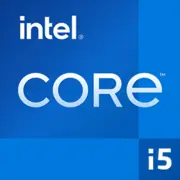Intel Core i5-1335U

Intel Core i5-1335U: A Balance Between Performance and Battery Life in 2025 Ultrabooks
March 2025
Architecture and Process Technology: A Hybrid Approach for Versatile Tasks
The Intel Core i5-1335U processor, released as part of the Raptor Lake-U line, retains a hybrid architecture while enhancing energy efficiency through optimizations in Intel 7 (10 nm Enhanced SuperFin). The chip combines two types of cores:
- P-Cores (Performance): 2 cores with Hyper-Threading (4 threads), base frequency of 1.8 GHz, maximum Turbo Boost frequency of up to 4.6 GHz.
- E-Cores (Efficient): 8 cores without multithreading (8 threads), frequency of 1.3–3.4 GHz.
The total number of threads is 12, and the L3 cache is increased to 12 MB. The integrated graphics Intel Iris Xe (96 EU) support 4K@120 Hz resolution, AV1 hardware acceleration, and HDMI 2.1. This enables external monitors to be connected without a discrete graphics card.
Key Architectural Features:
- Thread Director technology for optimal task distribution between P-Cores and E-Cores.
- Support for DDR5-5200 and LPDDR5x-6400 memory (up to 64 GB).
- Compatibility with Thunderbolt 4 and Wi-Fi 6E.
TDP 15 W: Energy Efficiency with No Compromises
The processor's nominal TDP is 15 W, but in turbo mode, power can temporarily reach 55 W. This is typical for ultrabooks with passive or compact active cooling. For example, in the Dell XPS 13 (2025), the chip consistently operates between 25–28 W under load, thanks to two fans.
Practical Implications of TDP:
- In office tasks (browser, Word), the processor consumes 5–8 W.
- During video rendering or code compilation — up to 35 W, but only for the first 2–3 minutes.
- In gaming (CS2 on low settings) — 12–15 W, focusing on the iGPU.
For comparison, the Core i7-1360P (28 W TDP) consumes 30–40% more power in similar scenarios.
Performance: From Office Tasks to Light Gaming
Office and Multimedia
- Geekbench 6: 1957 (Single-Core), 6115 (Multi-Core). This is 12% higher than the i5-1235U (Alder Lake).
- Real-World Tasks:
- Opening 30 tabs in Chrome + Zoom: No noticeable delays.
- Converting 4K video in HandBrake: 8–10 minutes for a 10-minute clip.
- Photoshop: Retouching photos with 10 layers — smooth operation.
Gaming
Iris Xe handles less demanding projects:
- CS2: 60–70 FPS (720p, low settings).
- Genshin Impact: 40–45 FPS (720p).
- Minecraft with shaders: 50–55 FPS (1080p).
Turbo Mode: In Cinebench R23 benchmarks, the chip scores 6890 points (maximum), but after 10 minutes, it drops to 5200 due to throttling, which is typical for thin laptops.
Use Cases: Who is the i5-1335U Suitable For?
1. Students and Office Workers — Document work, video conferencing, light presentation editing.
2. Digital Nomads — Battery life of up to 12 hours (in devices with a 60 Wh battery).
3. Casual Gamers — Games like Dota 2 or Stardew Valley.
4. Budget-Conscious Users — Laptops based on this CPU start at $700 (e.g., Acer Swift 3).
Not Suitable For:
- Professional videographers (better with i7 + RTX 4050).
- Streamers — insufficient power for simultaneous gaming and streaming.
Battery Life: How Intel Saves Charge
In web surfing, laptops with the i5-1335U achieve 10–12 hours (tested with PCMark 10 Modern Office). Technologies in play include:
- Intel Dynamic Tuning 2.0: Automatic frequency reduction during idle.
- Adaptix™ Sleep: Faster wake-up from sleep mode.
- Deep Learning Boost for optimizing background tasks.
Tip: Disable Turbo Boost in power settings to extend battery life by 15–20%.
Comparison with Competitors
AMD Ryzen 5 7540U (Zen 4, 4 nm)
- Pros: Better multithreading (8 Zen 4 cores), Radeon 740M is faster in games.
- Cons: Higher price ($800+), battery life 1–2 hours shorter.
Apple M3 (3 nm)
- Pros: 14 hours of operation, higher IPC.
- Cons: Limited compatibility with Windows software, no Thunderbolt support.
Intel Core i5-1235U
- 18% lower in multithreading performance, but $100–150 cheaper.
Pros and Cons of the i5-1335U
Strengths:
- Ideal for thin laptops.
- Support for Thunderbolt 4 and Wi-Fi 6E.
- Low temperatures, even under load.
Weaknesses:
- Limited performance in extended tasks.
- iGPU is weaker than Radeon 740M.
Recommendations for Choosing a Laptop
1. Device Type: Ultrabook (e.g., Lenovo Yoga Slim 7) or budget laptop (HP Pavilion Aero).
2. Display: IPS panel with 300 nits brightness and sRGB coverage of 95%+.
3. Memory: At least 16 GB LPDDR5.
4. Storage: PCIe 4.0 SSD from 512 GB.
5. Ports: 2x Thunderbolt 4 for future upgrade compatibility.
2025 Model Examples:
- Asus Zenbook 14: $750, 1.1 kg, 14" OLED.
- Microsoft Surface Laptop Go 3: $899, touch screen, 15 hours of battery life.
Final Conclusion
The Intel Core i5-1335U is an optimal choice for those seeking a lightweight laptop with a balance of price, battery life, and adequate power. It is suitable for:
- Work on the go.
- Studying and home use.
- Those not wishing to pay extra for excessive performance.
Key Benefits: Compatibility with the Windows ecosystem, support for modern communication standards, and a moderate price. If your budget is under $1000 and you're not chasing extreme power—this processor is your choice.
Basic
CPU Specifications
Memory Specifications
GPU Specifications
Miscellaneous
Benchmarks
Compared to Other CPU
Related CPU Comparisons
Share in social media
Or Link To Us
<a href="https://cputronic.com/cpu/intel-core-i5-1335u" target="_blank">Intel Core i5-1335U</a>

